|
|
The Twin Bee rides well on the
water and breaks fairly cleanly despite the four foot extension added
to the
hull aft of the cabin. Some pilots claim the Twin Bee operates
well
in three foot waves because of its rugged construction and STOL
capability.
|
The twenty four UC-1 Twin Bees made by STOL
Aircraft, Inc.during the 1980’s occupy a unique
place in aviation history. They were the last multi-engine flying boats
produced in the United States. Through a quirk of fate, mine, hull #23,
is the newest of the type still flying and, as
such, is a unique historical artifact. The FAA Aircraft Register lists
thirteen UC-1’s. NTSB accident reports show that three of these were
destroyed
in crashes. A correspondent tells me he has the engines off a fourth.
That
reduces the total to no more than nine. The Twin Bee indeed is indeed
an
endangered species.
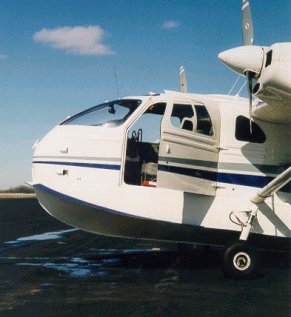
This detail of the rearward
opening cockpit doors demonstrates the potential problem should one
accidentally come open during flight. The doors have three
latches each as well as an emergency warning light. Also visible
is the Twin Bee’s roomy five place cabin.
|
When Joseph Gigante
and his colleagues of United Consultants undertook to design andproduce a
multi-engine amphibious flying boat, they decided not to go through
rigors of obtaining a new type certificate, but rather to modify the
existing Republic RC-3. They removed the 215 horsepower Franklin pusher
engine, added two and a
half feet to each wingtip, spliced a four foot section into the
fuselage
just aft of the cockpit and put two 180 horsepower Lycoming fuel
injected
IO-360 engines with constant speed, full feathering Hartzell propellers
atop
the wings.
The result was funny
looking and had serious center of gravity problems. It still looks
funny. The center of gravity problems were solved by increasing the 75
gallon main fuel tank to 85 gallons and adding a 16 gallon fuel tank
near the tail to or from which fuel can
be transferred in flight to adjust the center of gravity.
How does it fly? Over the past half century, I’ve learned that
funny looking planes fly funny. That said, let’s go for a ride.
You can get into very
serious trouble just
by not properly securing the doors. The pilotand copilot doors
are trapezoids measuring three feet by three feet that open to the
rear. As if the fact that an opening door would swing back and slam
into the fuselage were not enough, an errant door will also swing into
the propeller arc
and send the plane out of control. There are two extra fasteners on
each
door, a red flashing light if the doors are not locked and a steady
yellow
light if they are. What me worry?
Directional control
on the ground is a challenge. The vertical stabilizer is a huge flat
thing sticking twelve feet into
the air. The tail wheel swivels. The brakes fade when they get hot. A
quartering tailwind while taxiing on a narrow taxiway has embarrassed
the best of
us. Directional control on takeoff and landing is simplified by a
locking
tailwheel. Fear not, should you forget to lock it, you’ll know within
seconds
of advancing the power. Land with it unlocked and you stand a good
chance
of producing a 3,000 pound lump of crumpled sheet aluminum.
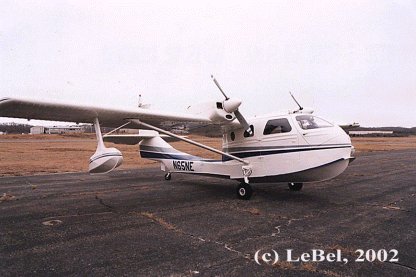 The Twin Bee’s relatively wide,
flat bottom is reminiscent of the Consolidated boats of the late
1930’s. The landing gear merely rotates out of the way for water
operations with no accompanying decrease in drag. The tail wheel
rotates ninety degrees clockwise. The Twin Bee’s relatively wide,
flat bottom is reminiscent of the Consolidated boats of the late
1930’s. The landing gear merely rotates out of the way for water
operations with no accompanying decrease in drag. The tail wheel
rotates ninety degrees clockwise.
|
Takeoff is
short, three hundred and seventy-five feet on land; eleven seconds
off the water. Like all flying boats,
adding power causes
the left wingtip to go down. This is not particularly serious
with
Lakes or RC-3’s, but the multi-engine boats have a propeller out there
that can suffer serious spray damage if the pilot is not careful.
Unlike the over-powered Widgeons, nose oscillation during takeoff is
not
likely and easily arrested should it
happen. From land or water,
takeoff is quick and spectacular.
A light twin (two wing mounted reciprocating engines and weighing
less than 6,000 lbs.) is not required to maintain altitude on one
engine.
The book says a Twin Bee will climb at about 200 feet per minute at
gross
with one feathered. However, NTSB records show at least one
instance
where it couldn’t. If someone shows you an ATP gotten in a Twin
Bee and all the events were honestly done, you stand in the presence of
a person to whom Chuck Yeager would demur.
During trimmed, steady-state cruise, every once in a while the
Twin Bee will
make up its mind to go wandering off. It suffers from phugoid, or
long term, oscillation. Try as one might, you can’t trim it
out. This doesn’t hurt anything or present a danger. It’s
annoying. During a five hour flight there will be several
unexpected minor “attitude excursions.”
Landing is a piece of cake with the caveat, “Thou Shalt Not Get
Slow!” With no flaps, the entire wing stalls at the same
time. With flaps down, the tips stall first, but not by
much. If you’re slow with low power, the Twin Bee can suddenly
drop out from under you. If you hit too hard bulkheads collapse,
rivet lines rupture and the hull floods.
Hit nose hit first and the part of Bernoulli’s Law speaking to the
greatest
force being perpendicular to the greatest curvature comes into play and
over
you go. NTSB records tell of an accident in which a student
attempting
a no-flap landing came to grief. The feds don’t speculate.
However, my reading of the report suggests the plane stalled, dropped
and flipped.
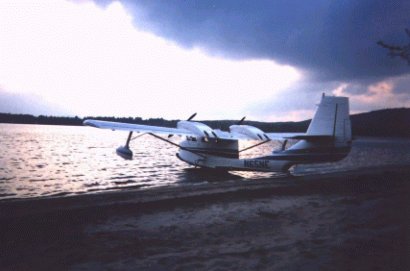 Traveller IV at rest on the shore of Pleasant Lake in the
Adirondacks at the FAA’s annual Seaplane Safety Seminar on Pleasant
Lake near Speculator, New York. Traveller IV at rest on the shore of Pleasant Lake in the
Adirondacks at the FAA’s annual Seaplane Safety Seminar on Pleasant
Lake near Speculator, New York.
|
Amphibians were designed without a landing gear warning
horn. Being a longtime member of that majority of amphib pilots
who have landed gear-up on a runway, I ordered Lake and Air’s “Landing
Gear Position Announcing System.” Now, for less than $2,000
installed, I have a nearly fool-proof system.
Flying boats failed as airliners because loading and unloading on
the water is inconvenient. The wingtip float keeps you from
siding up to a dock. Nose-to docking requires a crew, spring
lines and bumpers. Loading and unloading from a lighter at a
mooring usually degenerates into a gymnastics exhibition. The
most convenient way to load and unload a flying boat is on solid
ground, and even that is not always graceful. If you
must fly a boat, you have to accept that loading and unloading is not a
single person activity, and it usually requires special equipment.
Despite its looks, nasty habits and glacier slow cruise, I love
owning and flying a piece of history.
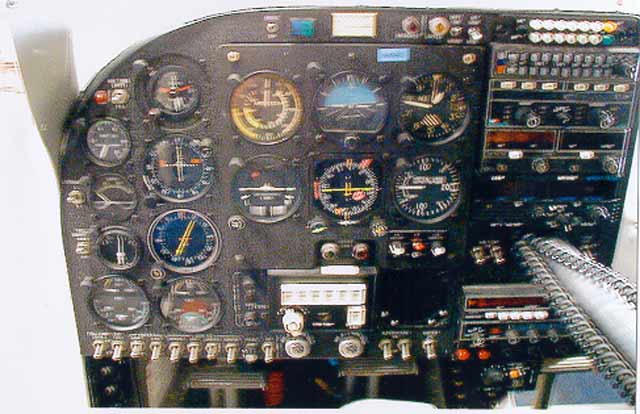 Traveller IV’s
instrument showing all the bells and whistles including a three axis
autopilot and GPS that this onetime Part 135 bird is fitted with. Traveller IV’s
instrument showing all the bells and whistles including a three axis
autopilot and GPS that this onetime Part 135 bird is fitted with. |
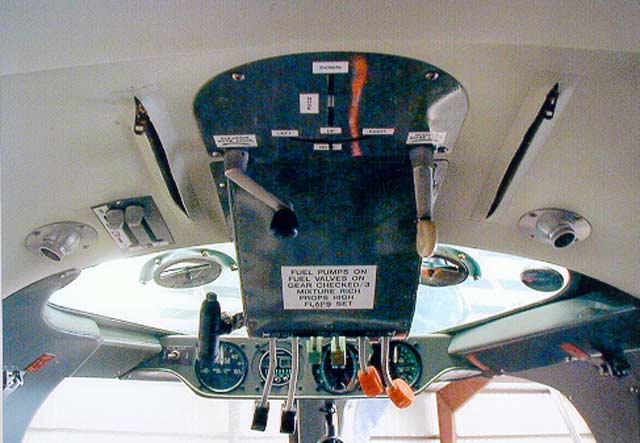 The overhead panel has the engine
controls, trim wheels and engine instruments. Reaching up to
change power settings seems a little strange to some when they first
start flying boats. In the foreground are the elevator and rudder
trim handles. Next is a panel light. The overhead panel has the engine
controls, trim wheels and engine instruments. Reaching up to
change power settings seems a little strange to some when they first
start flying boats. In the foreground are the elevator and rudder
trim handles. Next is a panel light. |
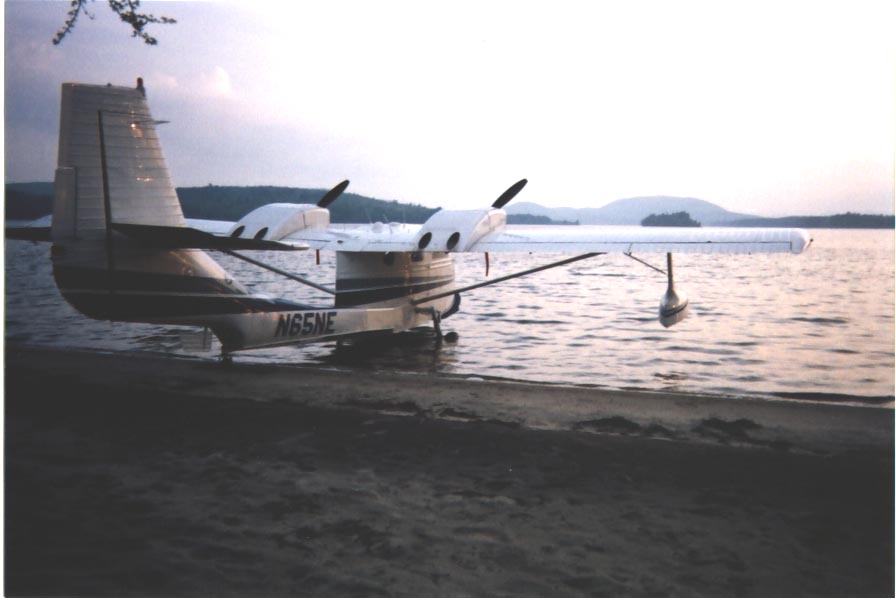
Traveller IV
beached. This shot typifies the difficulties with loading a
flying boat. If the surface is firm enough and there is enough
room, the flying boat can be taxied far enough onto the beach to allow
boarding from dry land.
|
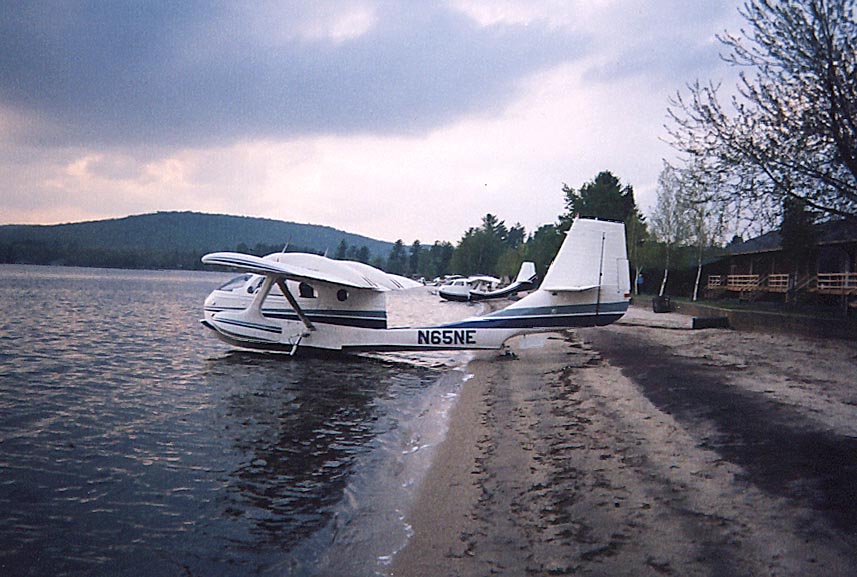 If the surface is
firm enough, the Twin Bee can be taxied far enough onto the beach to
allow passengers and freight to be loaded
on dry land. If not, you will get your feet wet. This shot
also show the advantage a flying boat with conventional gear has over a
flying boat with tricycle gear or a float plane when leaving the plane
“beached” over night. If the surface is
firm enough, the Twin Bee can be taxied far enough onto the beach to
allow passengers and freight to be loaded
on dry land. If not, you will get your feet wet. This shot
also show the advantage a flying boat with conventional gear has over a
flying boat with tricycle gear or a float plane when leaving the plane
“beached” over night.
|
 A deserted beach
after the FAA’s safety seminar at Camp of the Woods on Pleasant Lake
near Speculator, NY. An amphibious flying boat, such as the Twin Bee,
has the advantages of being able to operate from a hard surface, a
remote lake
and in the IFR airways system. A deserted beach
after the FAA’s safety seminar at Camp of the Woods on Pleasant Lake
near Speculator, NY. An amphibious flying boat, such as the Twin Bee,
has the advantages of being able to operate from a hard surface, a
remote lake
and in the IFR airways system.
|
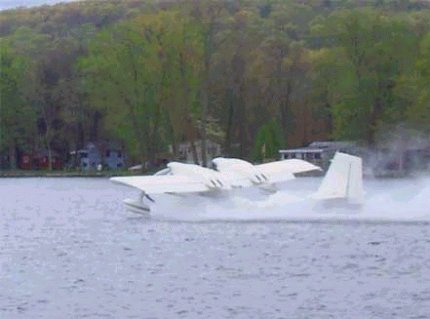 Traveller IV on take
off on the Connecticut River near the Goodspeed Seaplane Base. The
plane is just rising on the step. Shortly, the pilot will correct
the left wing low condition characteristic of a flying boat at this
stage of acceleration, and complete take off. Traveller IV on take
off on the Connecticut River near the Goodspeed Seaplane Base. The
plane is just rising on the step. Shortly, the pilot will correct
the left wing low condition characteristic of a flying boat at this
stage of acceleration, and complete take off.
|
|